July 2020 - the sculpture garden as it was when Stephanie and I first discussed the project.
February 2021. After the Texas freeze
May 2022 - 12 months from installation.
Your Custom Text Here

July 2020 - the sculpture garden as it was when Stephanie and I first discussed the project.

February 2021. After the Texas freeze

May 2022 - 12 months from installation.
Land art or earth art has paved the way for what I hope will become a new art movement.
The Tate defines Land art or earth art as the art made directly in the landscape, sculpting the land itself into earthworks or making structures in the landscape using natural materials such as rocks or twigs. With the Tate's definitions, Symbiosis is land art, a part of the conceptual art movement, and environmental art.
What separates Symbiosis from these traditional classifications of art are the concepts I apply to my creative decision-making process and the materials I use support and regenerate life. It values all living creatures as participants in the creative process.
My process for creating a living sculpture involves holistic decision-making. First, I incorporate a systems thinking approach to create a functional balance between the healthy ecosystem, human economics and societal landscape norms. For example, contemporary landscape designs are structured in monocrop rows or groupings separated with bare earth. To maintain the manicured design, weed-killing chemicals and gas-operated mowers and edgers are the most economical. This lack of plant diversity, geometric-in-shape groomed plantings, and chemical inputs make these landscapes uninhabitable for a diversity of wildlife other than a few lizards. For many valuable insects and microorganisms, the inputs are deadly. These designs do not consider supporting the food chain necessary in a healthy ecosystem. In Symbiosis, I keep the ground covered with a diversity of plantings that drift in and out of each other and with the seasons; this provides camouflage from predators, nesting materials, and a variety of nourishment all year. Weeds fit into this landscape and help build the microorganisms and structure or armature in the soil. This less structured planting design is balanced with a classical symmetrical layout. Symbiosis is designed to build the food chain. The maintenance required is easily accomplished with handheld clippers. The clippings are put back into the garden to decompose by insects and natural systems that build the soil health and retain water and carbon, or into a vase to be enjoyed. Ultimately Lawndale benefits economically through lower maintenance, chemical inputs, and utility costs, while enjoying a toxin-free environment—living sculpture.
I use materials that support plants and wildlife specific to the site's ecological history. I begin with a water source, animal waste and decaying plant materials native to the area. These materials build habitat and nourishment for microorganisms in the soil, in the water feature and up the food chain to sustain each other in extreme Texas weather. When combined with our clay soil they: store carbon, cool and return water to the aquifer, support life beneficial to humans and keep harmful pests at bay. In addition, they assist in cleaning the air, slowing rainwater, and reducing land erosion.
For example, I have created symbiotic relationships between humans, mosquitos, dragonflies, fish, and chemical-free water. In a hot environment, animals need a freshwater source to drink and reproduce. I installed a small pond without a filter or pump. Using plants to filter the water, I utilize the eating and waste habits of the Texas Mosquitofish to control the algae and build the water's biology. Mosquitos and dragonflies are attracted to still water with a balance of healthy bacteria and algae to deposit their larvae. The larvae become protein for the fish. Attracted by the water source, the dragonflies hover above the garden and on dried plant materials hunting mosquitos, supporting human health. Lawndale benefits economically by not utilizing an electric pump, needing a mosquito misting machine or pesticides and enjoys the beauty of the water feature and a kinetic, ephemeral rainbow of dragonflies hovering and darting over the living sculpture.
In Symbiosis, as the lower food chains develop, it begins to regenerate life and recover what is lost. Perpetual, it is art for now and future generations. In a living sculpture, the ways to evaluate it are space, shape, line, color, texture and regeneration.
I submit below images and descriptions of symbiotic relationships, ephemeral parts of the installation from April 2021-April 2022.
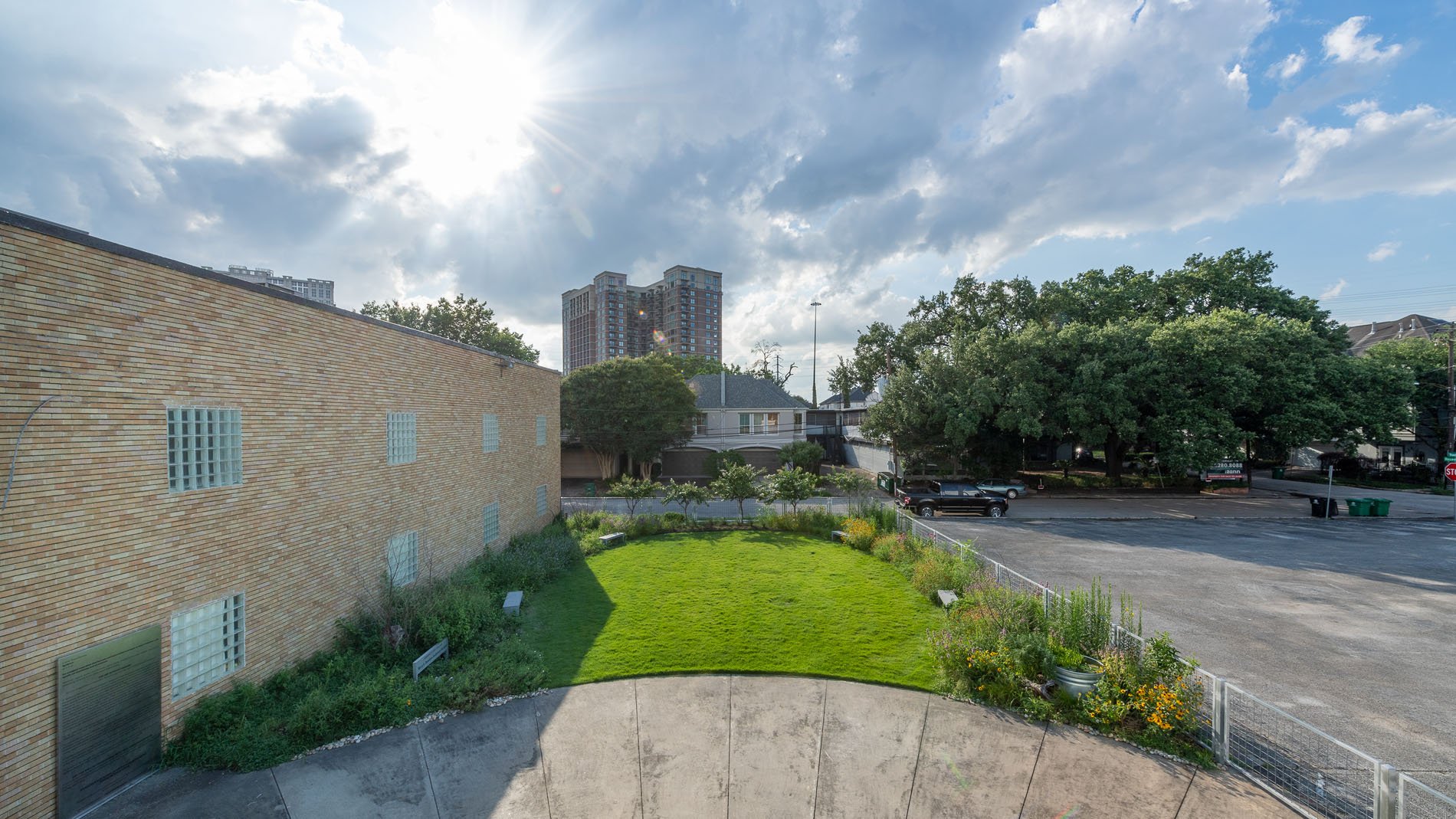

Dung loving birds nest fungus

Gulf Fritillary butterfly on rosin weed sunflower. It roots can extend 16’.
image by Nash Baker courtesy of Lawndale Art Center

Black Swallowtail (Papilio polyxenes) on Monarda citriodora lemon beebalm image by Nash Baker courtesy of Lawndale Art Center.

Gulf fritillary butterfly on Gulf verain Verbena xutha image by Nash Baker courtesy of Lawndale Art Center

Battus philenor a pipevine swallowtail

Gulf fritillary on Rudkeckia hirta

Long-tailed skipper Urbanus proteus on Salvia azure

Junonia coenia the common buckeye butterfly on a blanket flower Gaillardia puchella with dew drops.

Black Swallowtail (Papilio polyxenes) on scarlet sage Salvia coccinea.

Gulf Fritillary butterfly on purple cone flower

Red arrow Rhodothemis lieftincki on dead olive tree limb.
Mosquito control and water source for winged species.
Past bushy blue stem and Seaside Golden rod. I leave them through March so the winds can spread their seeds to other gardens, and to provide shelter for birds, tree frogs, toads, and field mice.

Plathemis Whitetail Skimmer



Mosquito control and water source for winged species.

Past bushy blue stem and Seaside Golden rod. I leave them through March so the winds can spread their seeds to other gardens, and to provide shelter for birds, tree frogs, toads, and field mice.
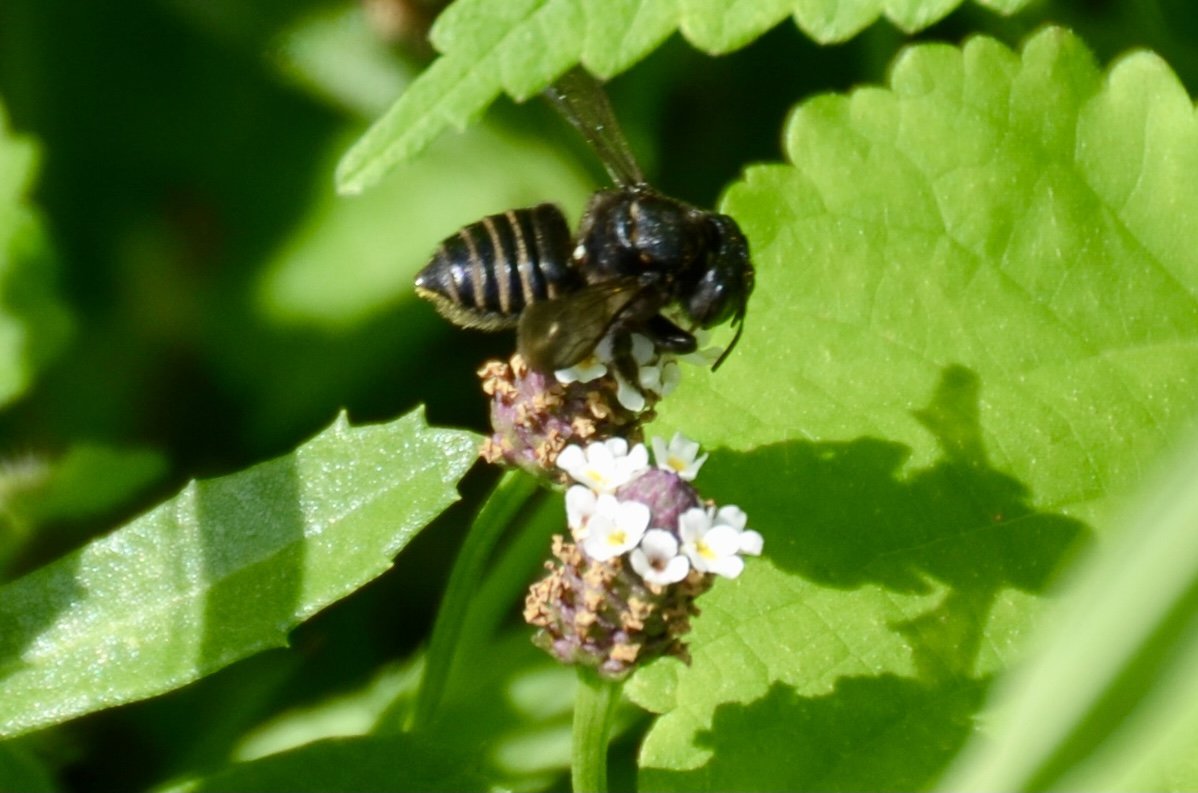








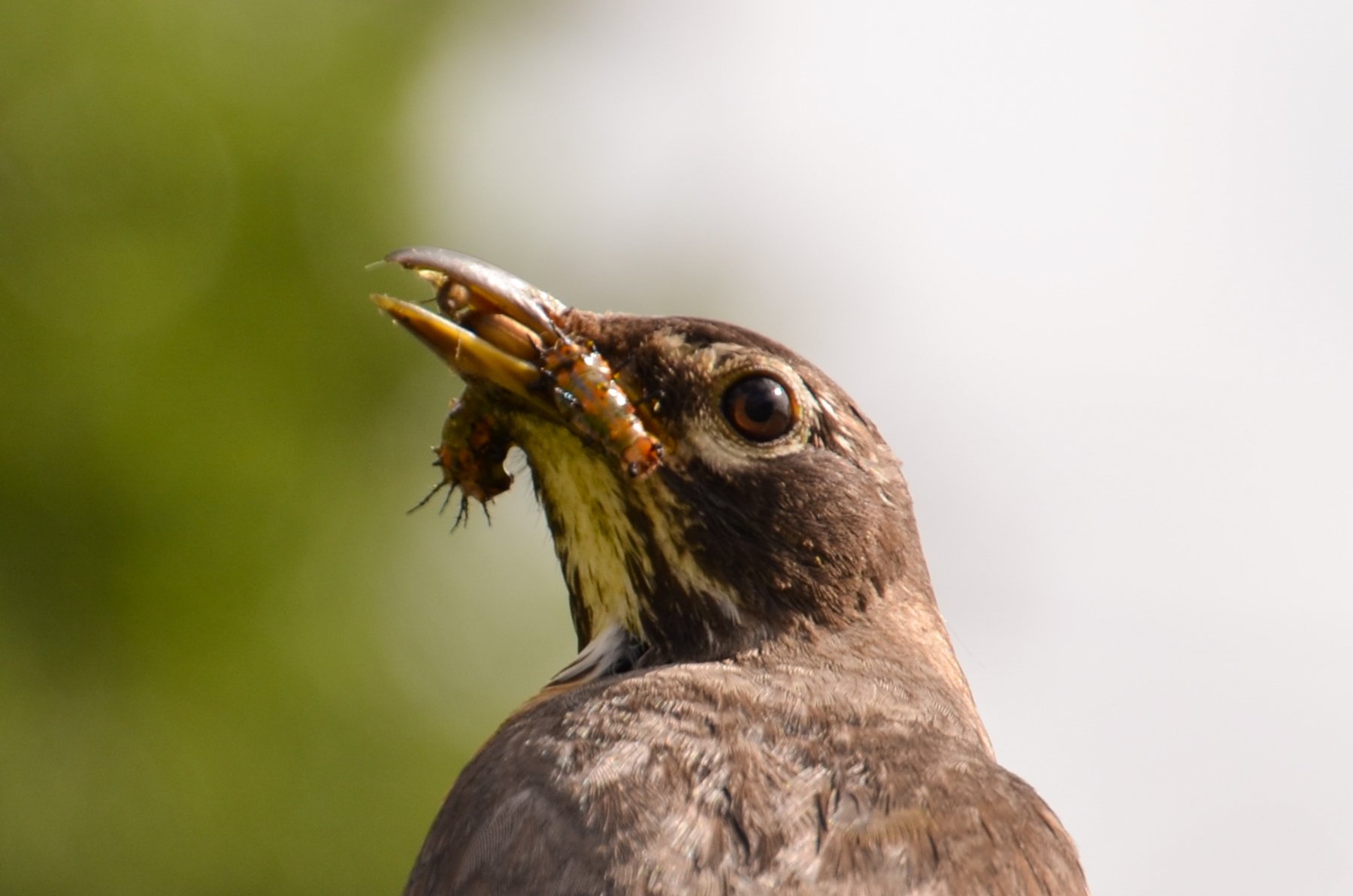











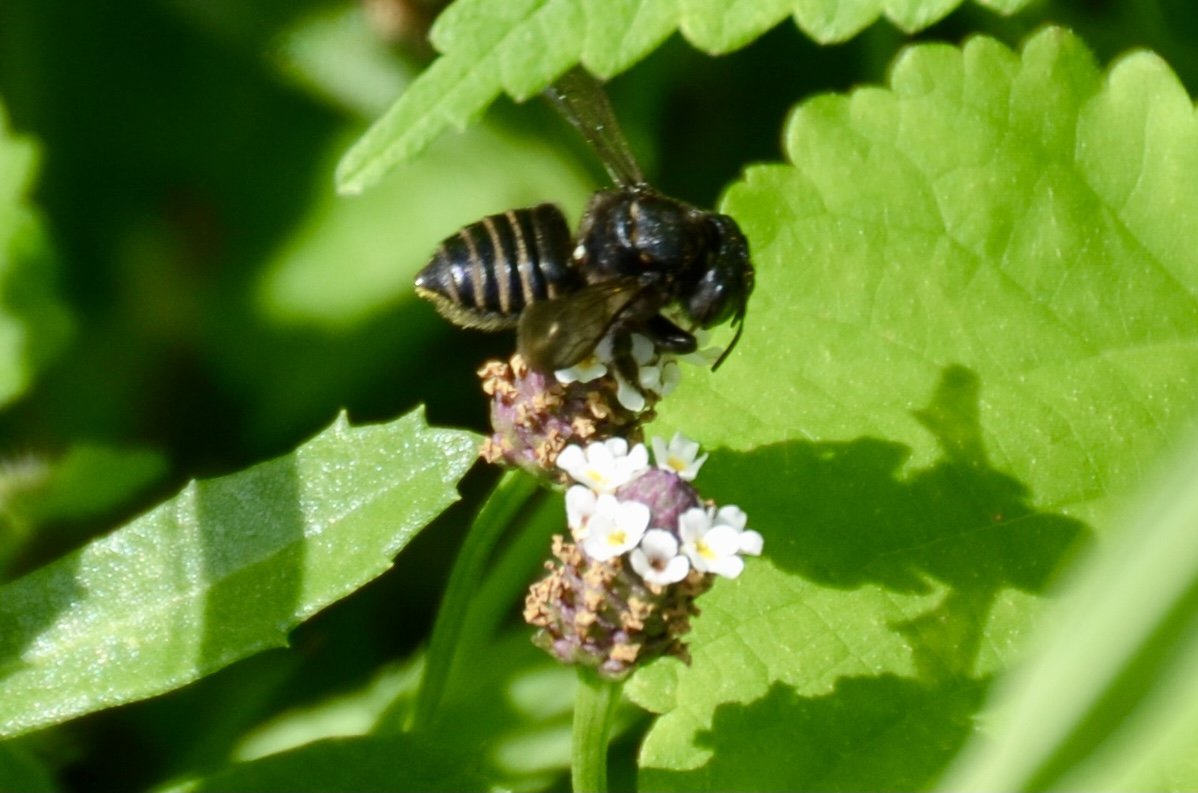




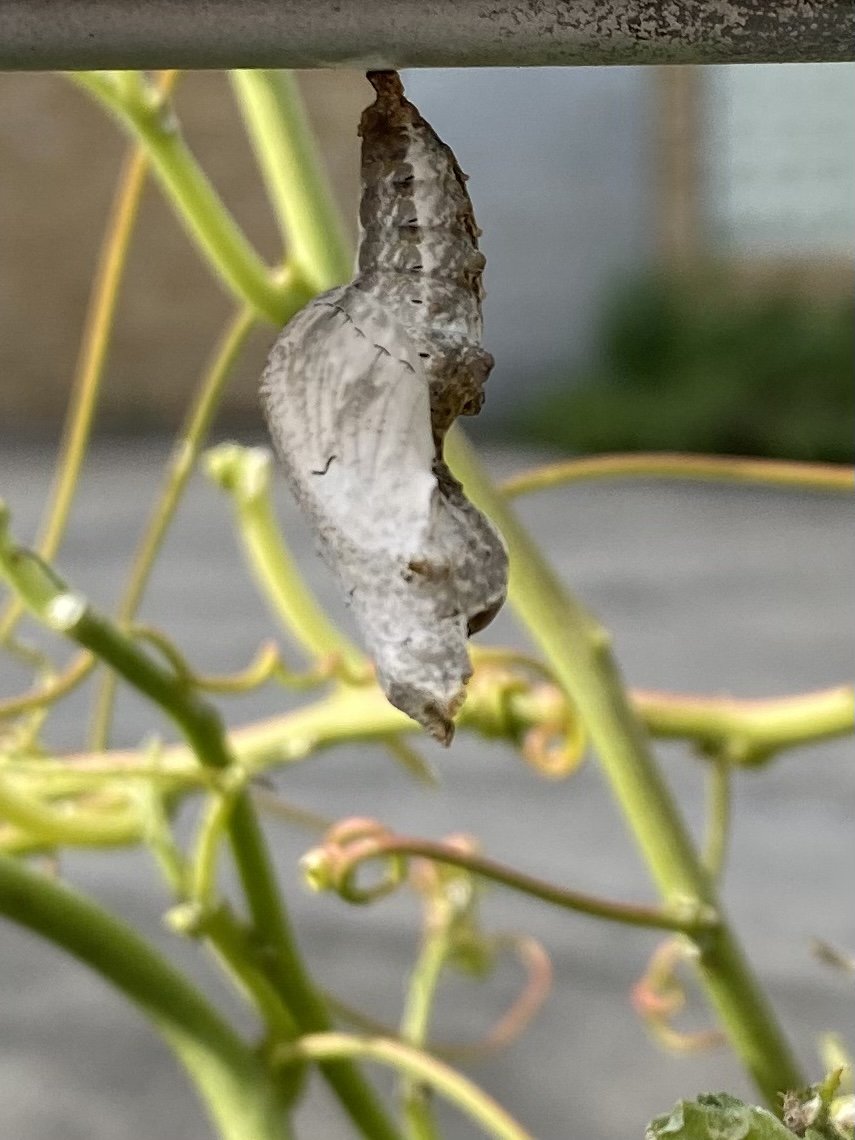



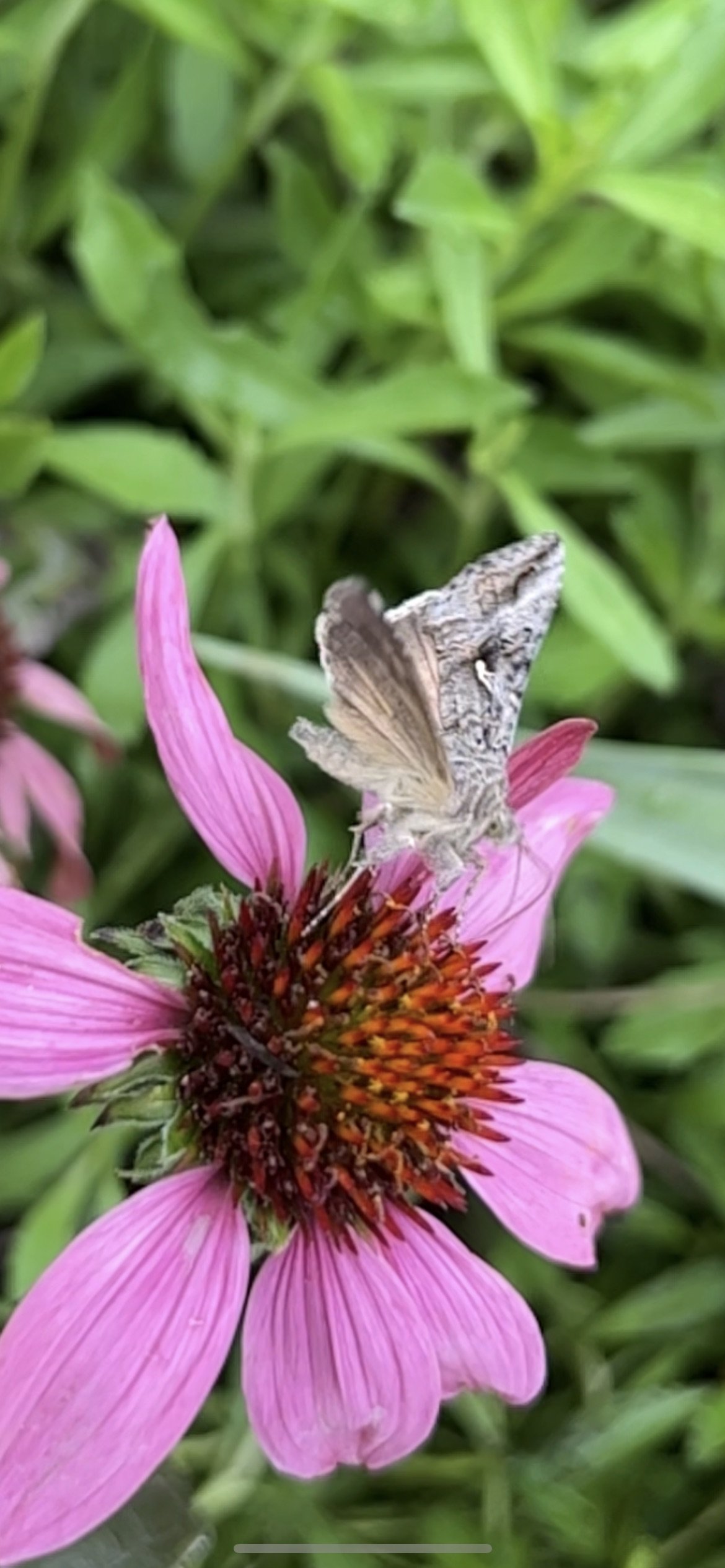

Brown skipper and Rudbeckia hirta
Cindee Travis Klement
Endangered Knowledge: The Soul of Humus
Long Term Proposal - sponsorship and site selection
Sponsorship from the energy industry can mutually benefit from my long-term plan.
How can this work be valuable to the energy industry?
I read in the Houston Chronicle that oil firms wrestle with public image. And, I have read that these same companies are starting to look at agriculture to regenerate the planet and return carbon to our soil for future generations. So, sponsoring my carbons sequestering figurative sculpture can be a tool to build a positive public image, support the environment through educating the public with the natural history it represents, and support the arts and female artists.
What is my long-term vision for the piece?
I believe that we cannot fix our environmental issues if we as a society do not understand how our environment works. Therefore, I made Endangered Knowledge: The Soul of Humus an educational, ecological work for now and for civilizations to come. My vision is to exhibit the work in a high-traffic location on Houston's Buffalo Bayou with the Energy city skyline behind it. The tension of the great bison created out of the indigenous earth and organic material placed against the glass skyline of the energy city will permanently record this endangered knowledge to the citizens and visitors of the coastal prairies collective memory. It will plant the seeds to holistically balance the needs of humanity and wildlife in urban landscapes. I will be a reminder of our collective responsibility of sequestering carbon, soaking up rainwater, and cooling the planet, extending our time on the earth. For the piece to stand the weather, it will be cast in bronze.
How can this sculpture be valuable to the Buffalo Bayou Partnership and the city of Houston?
In the early 2000s, I chaired my daughter's high school environmental social service project. I organized a clean-up on Buffalo bayou for the 16-year-olds. We were pretty new to Houston, and I was curious about Buffalo Bayou's name. After some research, I learned the last bison herd was seen just after the Alamo. A few years later, I discovered the connection between grazing herds, soil health, food production, sequestering carbon, and soaking up rainwater. All these things are crucial to human existence, yet it is unknown by most of the population. Buffalo Bayou is Houston's most significant natural resource, a natural landmark. It is the site my environmental sculpture can have the most important environmental impact. Below is an image of the site I envision for the piece.
What will it cost?
Over the last eight years, I have built a relationship with Legacy Fine Arts Foundry, a minority woman-owned foundry. We have worked out a process to direct cast organic material into bronze. I can show you samples in my studio. The work will not look like a bronze monument it will be a work of art. The process is similar to that of Joe Havel and Linda Ridgeway but adapted to my organic materials. This piece will take the process of direct casting to a whole new level. I project the project will come in between $150,000 - $260,000. That would include a production cost of roughly $100,000., transportation, engineering fees, site preparation, lighting, installation, insurance, artist, consultant fees, etc. Much of the cost is dependent on the site.

The image above is the type of skyline I envision in the background of the proposed installation. The old male bison would be grazing on low-growing native prairie grasses. A few feet behind him, visitors would see cast bronze dung, mushrooms, birds, and dung beetles. The work would not need the granite pedestal as pictured. There are also some suitable sites on Memorial.

As geologists and environmentalists battle, “are we in the Holocene epoch or have we made our mark on Earth and entered a new geological period, the Anthropocene?”, I ponder weeds.
The term weed, in the Holocene, is a plant that sticks out in a monoculture. From a bipedal primate’s perspective, a weed isn’t like all the surrounding plants: we undervalue it—because it “looks” different. From a human who spells her name Cindee with two ee’s, I have to say I am attracted to weeds and not just because of the ees. Since my first installation in Symbiosis, on February 14, 2021, I have thought a lot about the word, verb, and the thing weed, asking myself so many questions and finding answers in this urban garden.
In nature and in Symbiosis, I observe weeds and now see them as Earth’s first responders to large or small ecological disasters. Weeds are seeds, roots, stems, leaves, berries, and blooms—organic matter. Weeds are vegetative volunteers in the ecological services division of Earth; they provide emergency services for its living organisms above and below ground. Hear me out — when the Earth’s green skin is left bare, tilled, stripped, eroded, poisoned, burned, flooded, neglected, or disturbed by natural or human occurrences, Mother Earth cherry-picks from embryos sleeping in the soil her first responders—our weeds-seeds. Like our own“compounded prescriptions,” seeds are biologically programmed for the site’s specific ecological condition—temperature, moisture, and daylight—to grow fast and spread quickly; they are speed healers. As they mature, I see emergency room physicians administering oxygen masks for underground organisms, protective bandages for the Earth’s epidermis, and poison antidotes. Their organic matter lowers the Earth’stemperatures, thereby keeping soil and its living microorganisms alive. And they provide shelter, food, and nectar for the site’s microorganisms, wildlife, and humans. These ecological first responders are full-service providers, slowing rainwater, reducing soil erosion, replenishing the aquifer, cooling the planet, sequestering carbon, and stabilizing it in the ground for those debating geological periods to come.
From a sculptural perspective, if the shape, texture, or color of a volunteer first responder “weed” does not satisfy my artistic vision, I no longer yank it out of the ground in a knee-jerk response. I stop—look—think, why was it sent in? I take a holistic approach. I weigh the service it is providing our above and below ground micro-ecosystem, the armature that supports the life of the sculpture. I then consider what human adjustments I might implement to holistically balance these roles nature’s first responders are providing to achieve my artistic vision, supporting my sculpture. I consider the needs of other species from the bacteria, fungi, nematodes, and insects to the small mammals, birds, and humans whose life work supports my work. I know that the small systems have to be right for the global systems to run smoothly and I see that too much is at risk to resort to pesticides. I create ways that weeds’ delicately shaped blooms can work in my living land art.
From a practical standpoint, weeds are convenient, cost-effective tools in my human-made nature scape, a catalyst for environmental change, Symbiosis. So, while intellectuals debate the ages, I get out of weeds way, pull over to the right and let the weeds do their job.
In Wikipedia, weed is “of unknown origin.” Ironically, weeds are of unknown origins in most landscapes. So I break down the word weed into three parts.
We – all of us, me, you and I.
ee – In the English language, double e’s are a tool to
denote one connected.
ed – denotes verb, performs an action.
Holocene or Anthropocene? In this age of uncertainty, if humans “weed out” weeding, can all species win the battle? — I wonder…
Additional Weed Readings
WEEDS Control Without Poisons, by Charles Walters.
WHEN WEEDS TALK, by Jay, L. McCaman — includes charts with the functions of each species.
I purchased my copies on Acres USA.

Wood-sorrel exhibits nyctinasty, likely helping the plant conserve energy. It forms a taproot and is upright when young, but as it grows, its long, multibranched stems eventually flop over and trail out along the ground for as much as two feet, extending rootlets from nodes along the stem. This root is beneficial in breaking up the clay. Sorrels contain oxalates, a naturally occurring molecules that bind with calcium. If your soil needs calcium, keep the wood-sorrel.

Youngia japonica a member of the aster family and related to the dandelions. Dandelions Taraxacum officinale shows up when soil is low in calcium and compacted. The local bees, butterflies, birds, and I enjoy the blooms while the dandelion roots break up the clay. Their leaves are loaded with antioxidants and used by herbalists for many health issues.

I believe the above plant to be Cudweed. Cudweed is host for the American painted lady butterfly.
Why we shouldn’t rag on ragweed? The seeds of ragweed are rich in fatty oils. Fats are not only Ebut also is for fattening up birds and small mammals such as Eastern Cottontail, Meadow Vole, grasshoppers which eat the leaves, Dark-eyed Junco, Brown-headed Cowbird, Northern Bobwhite, Purple Finch, Mourning Dove, American Goldfinch, and the Red-bellied Woodpeckers to get them through the lean winter months.
It is an ancient grain for humans and ragweed is a valuable food source for the caterpillars of many butterflies and moths including the striking wavy-lined emerald and the uniquely adapted bird dropping moths. The seeds of ragweed are rich in fatty oils. Birds and small mammals readily consume ragweed seeds to help fatten up for the lean months to come.
I will use this post to document my experiences with weeds.
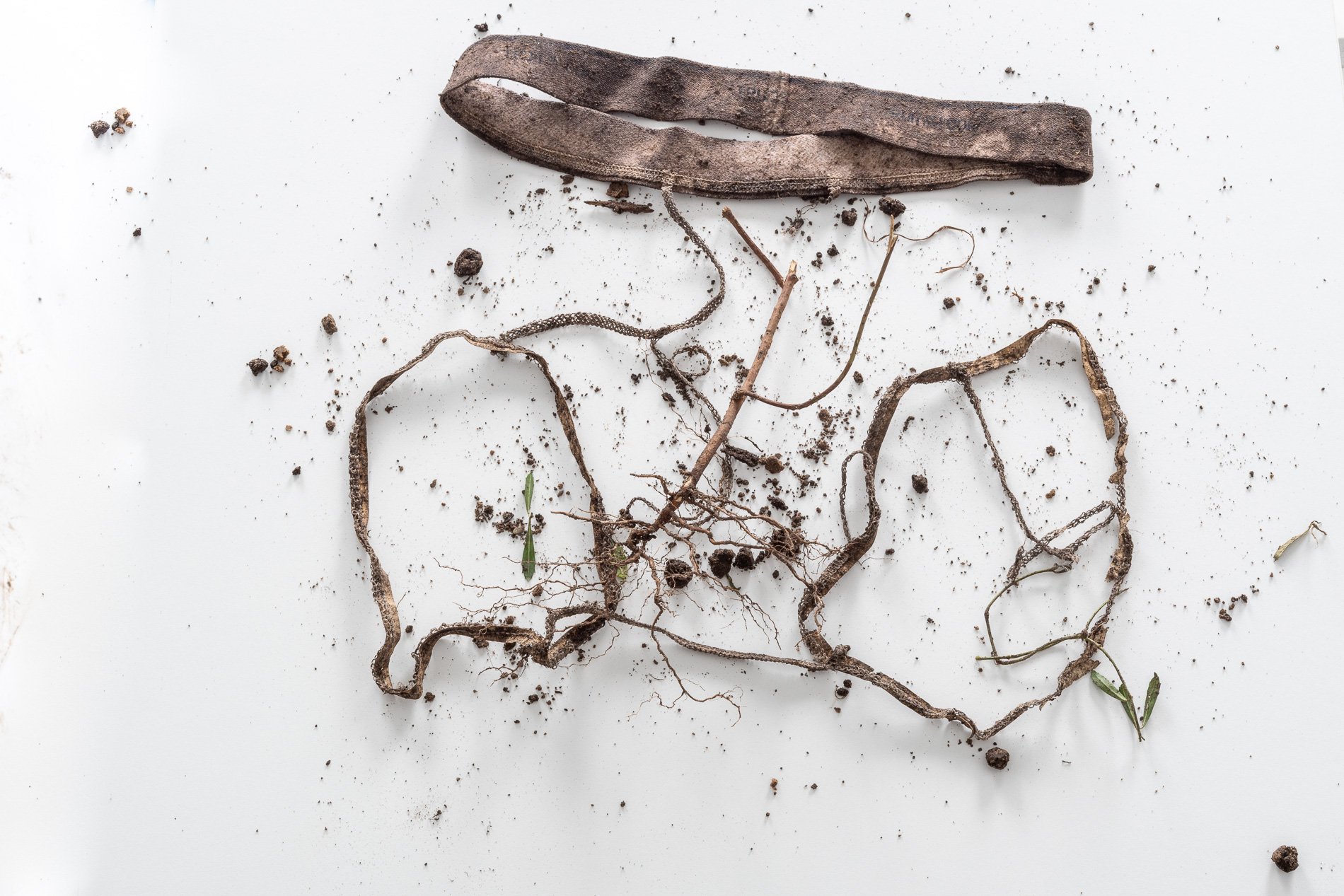
SOILED — Tighty-Whities 2021
Photograph by N. Baker
How do you document art that lives beneath our feet? Creating art beneath the Earth’s surface I am finding new ways to document the work and it's movement. This photograph is the result. Let me explain. To test soil for fungi that recycle wood and live on dead material soil, scientists buried cotton fabric. In Symbiosis, to document the Saprophytic fungi, I planted new, washed men's medium cotton briefs. This photograph demonstrates the results. In 2022 I will recreate the piece and grow the tighty-whities in a vertical column. This change will document that living soil, the diversity of microbes is built from the top down. In contrast, when my father farmed in the 50s and 60s, the farm bureau that advised him told him to invest in a new plow to dig deeper to access the richest soil.
The purpose of my work is to change how we see landscape. It isn’t just about creating beautiful gardens. Landscape can store carbon and soak up rainwater to cool the planet. It is the cheapest and fastest way to get our planet back on track.

Digging up the briefs I immediately knew I had made a mistake. I left them In the garden’s soil too long. Still, I dug them out with tender care. The petroleum-based elastic band was entwined with a plant root. The root took the elastic leg 6” deeper into the earth than I planted it. I left the elastic and the root as I found them. Laid them on a board and took them immediately to Nash’s photography studio to document the work.
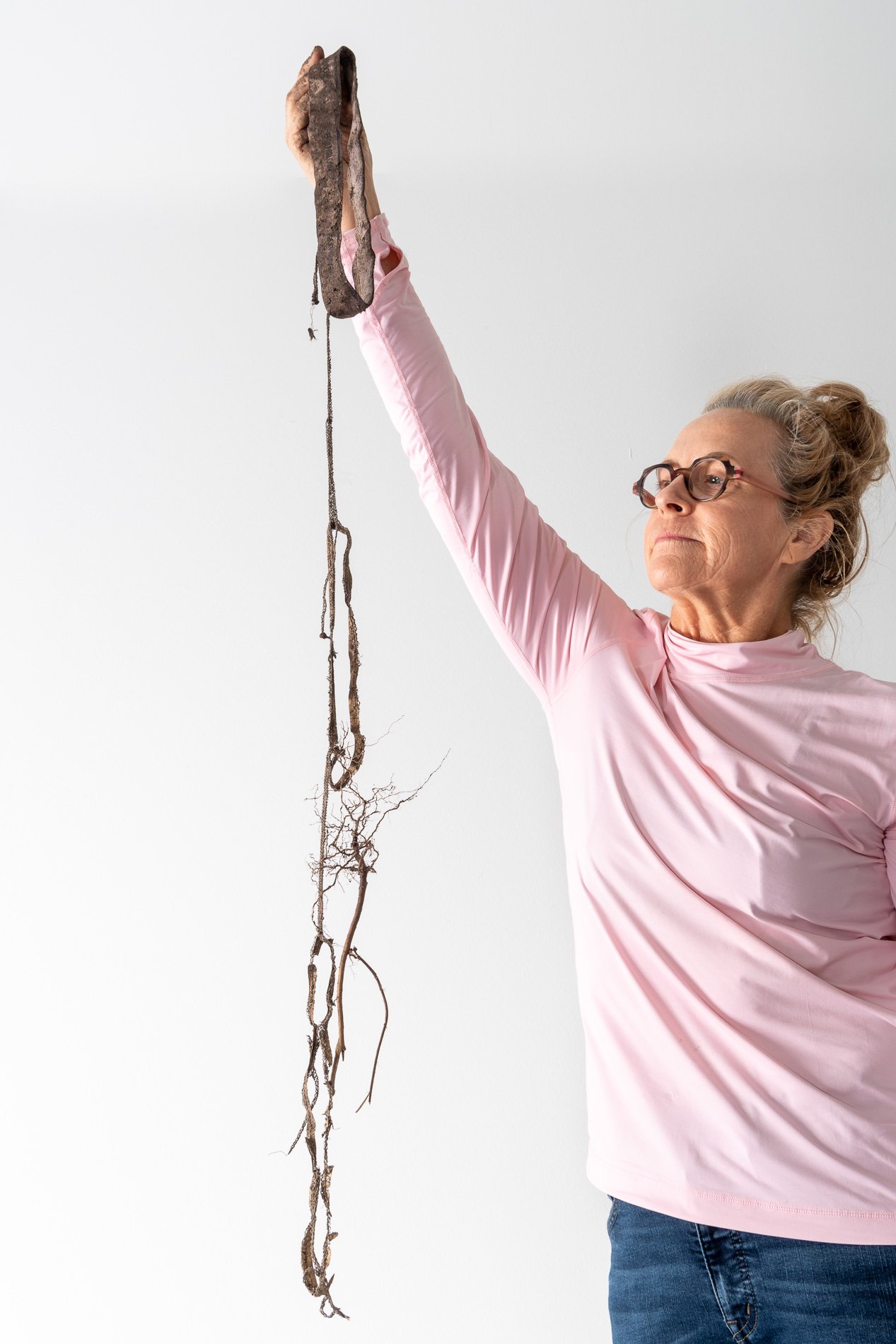
First, I delicately untangled the elastic. The cotton had completely decayed. The elastic was not biodegradable.

Seeing that the briefs were still intact minus the cotton and plus the root I started reassembling the briefs and the added appendage.

In art many times you have to listen to the materials.

Carbon by the Yard
Zoysia Turfgrass relief
35' X 48'
Embedded within the installation Symbiosis, Carbon by the Yard is a temporary, living sculpture in the shape of the Carbon element symbol, C. The work consists of carving a 16 x 14-foot shape into the existing grass, and allowing the Zoysia grass to grow tall around it. A simple gesture, the letter brings attention to the role lawn-grass plays in climate change. In 2020, the Environmental Protection Agency estimated that grass uses up about a third of all public water: in the US, this translates to 9 billion gallons of water every day. Our mowers consume 200 million gallons of gas. The U.S. Environmental Protection Agency estimates that, gas-powered lawn mowers produce 11 times as much pollution as a new car hour for hour. And, manicured lawns provide no livable habitats for pollinators or the other plants and animals necessary to maintain a healthy ecosystem. With Carbon by the Yard, artist-environmentalist Cindee Klement brings attention to the ways in which our daily decisions can help to reduce our carbon footprints.
Reducing nitrate leaching losses from turfgrass fertilization of residential lawns

The sketch for Lawndale approval
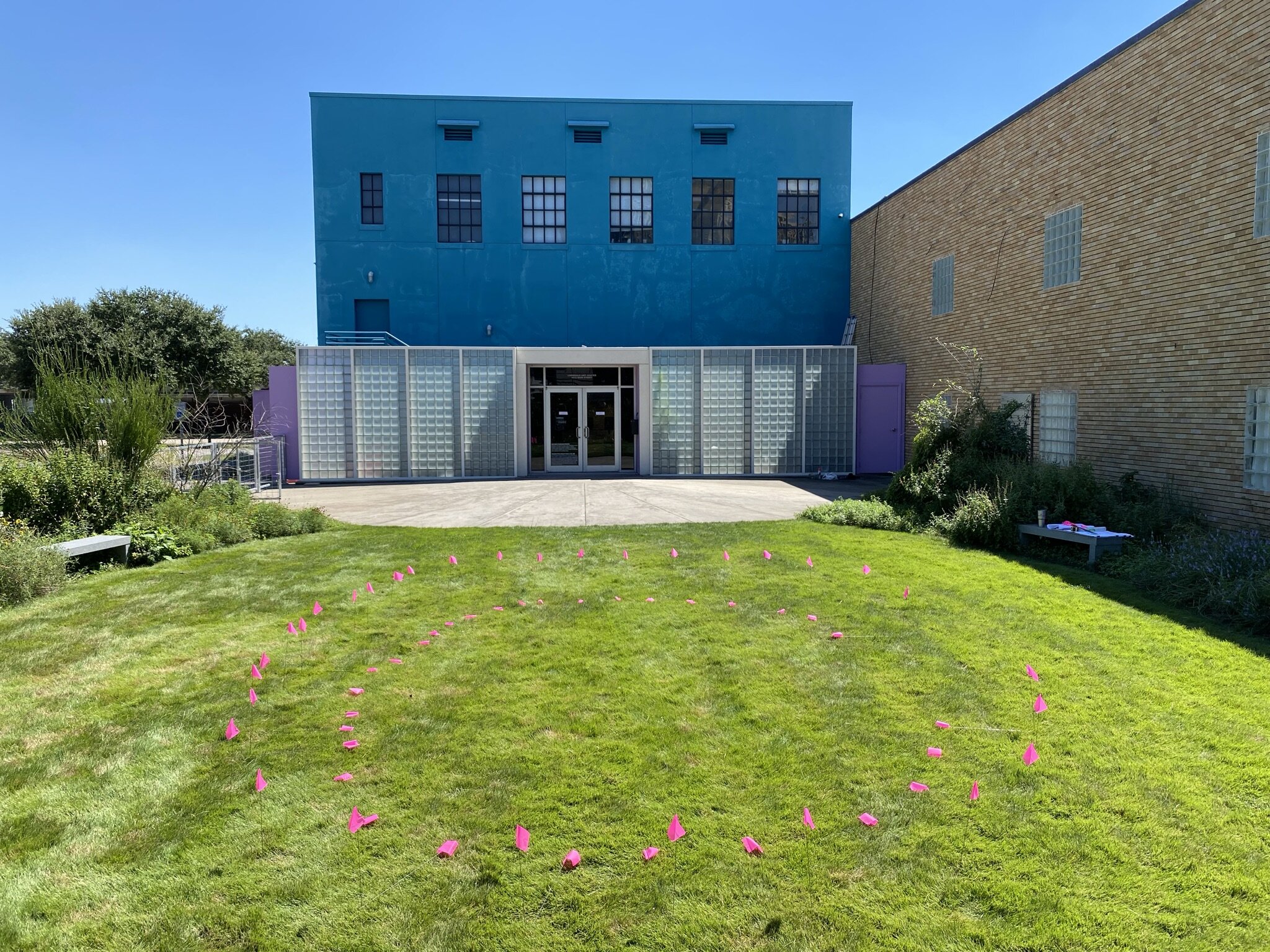
September 23, 2021
I sketched the C into the space with flags. Moving and adjusting them until I had the shape C right and in the right place.

Next I marked the C with a water base paint used to mark fields.

The C marked in water based paint.

October24th- The first cutting.
The yard maintenance company used their regular mower. The CO2, cost, time, and noise pollution of the gass lawn mower was not worth the result.

I was afraid that the following week the lawn maintenance company would not be able to see the relief enough to remow it. I remarked the C with the flags.
The second cutting was rained out.
I will update this blog post through out the process.

October 8th - week three cutting #2

October 18th - Week 4 cutting #3

October 22 - week 5 cutting #4
After 4 cuttings the C is now beginning srand out.

November 1- week 6 cutting #5

November 7- week #7cutting #6

November 12th, week #8 cutting #7

November 19th, week #9 cutting #8

November 26th, week #10 cutting #9

December 3rd, week #11 cutting #10

December 24th, week #14 cutting #13

January 9, week #16 cutting #15
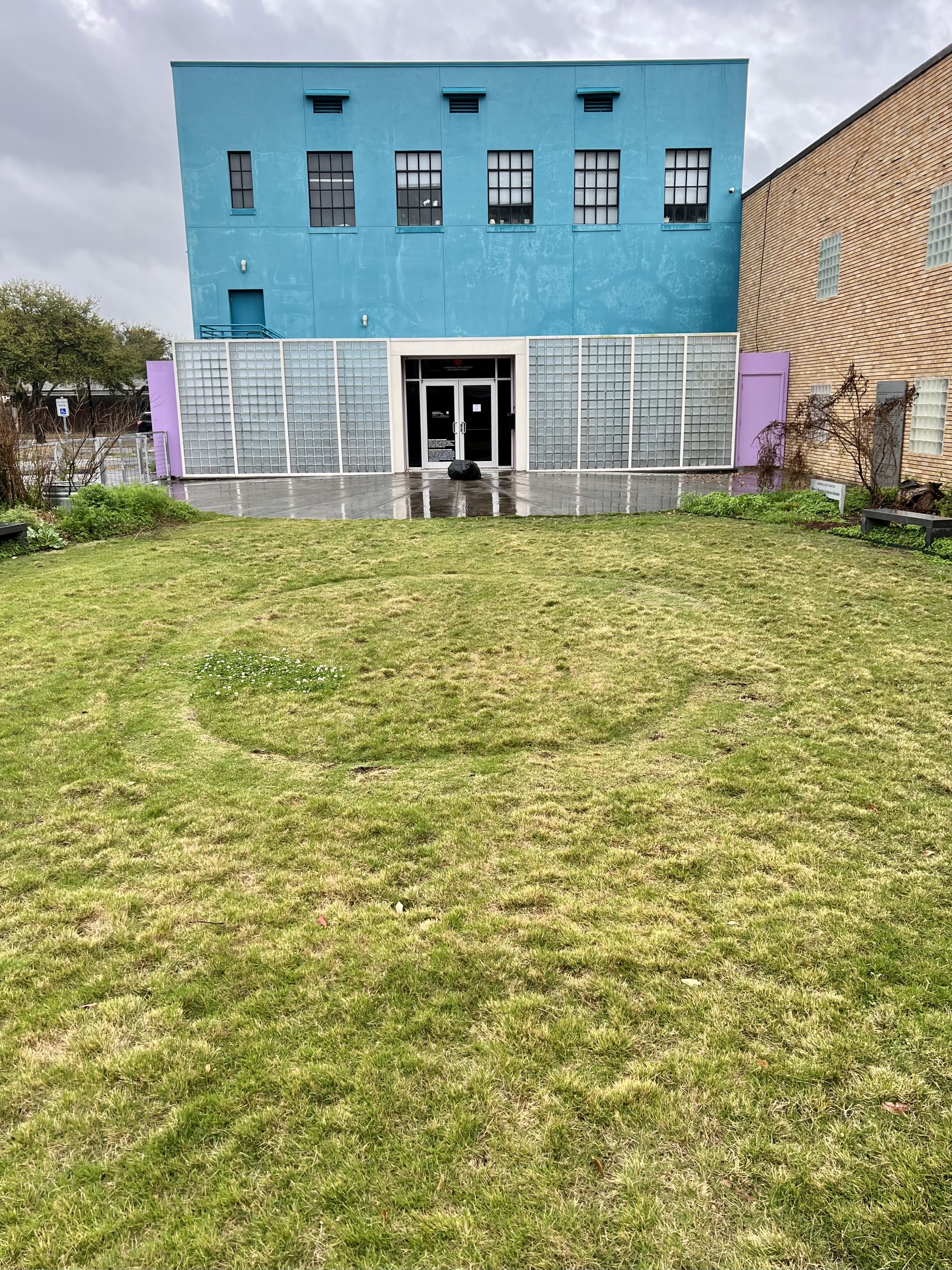
March 30 - this would have been week 29……. Unfortunately, it is not.
I noticed the grass was growing exceptionally slow. Long story short Lawndale’s lawn maintenance company was mowing on a high setting.
I am starting over on counting weeks of emissions saved.

April 10th, week 1, not cutting the yard #1

Spring 2022

August 2022
For several weeks I have noticed the neighborhood birds are not stopping into Symbiosis. I have asked the neighbors and they have noticed the birds were absent too. Today an article came out in the Houston chronicle, Songbirds Take a Break.

March 19th - first bird in garden. An Amerucan red robin foraging for insects, bugs, protein or seeds, poking it's beak into the newly installed living compost.

March 31, 2021 robin hunting for grubs as I install the American beautyberry.

April 9, 2021 robin on the oak stump. I installed rotting native tree stumps to give the birds a camouflaged lookout and hideout.

April 9, 2021 dove

May 22, 2021,
blue jay

May 1, 2021 American red robin

June 19, 2021

June 22, 2021

The armature with lath wired to it. Both back legs have material tests on them.
The surface material and how it will age/dry is a mystery. The arnature is the same atmature that I have used on all of my life size sculptures. The late Donald Tucker a local faux bois artist taught me this method. On the faux bous furniture, the finish is a concrete composite. On the other life size sculptures I have used concrete and hydro stone.

BROKEN
steel, reinforced concrete, and wire
40" X 29" X 55"
2018
photo by Nash Baker

Sonata in 4D - welded steel, lath, wire and plaster
2018
Photo by Nash Baker

HARVEY HEROES - LIVEstock BRINGING HOME THE BACON
66” X 42” X 60” - welded steel, lath, wire, wire cloth and hydro stone.
2019

Anniversary bench- Welded steel, concrete
2011

Mark Morganstern of Morning Star Prairie Plants invited me to join him to collect seeds for Symbiosis at the Nature Concervancy’s Nash Prairie Preserve. “The 400-acre tract is one of the last remaining segments of the Great Coastal Prairie, which once encompassed six million acres between Lafayette, Louisiana and Corpus Christi, Texas. Nash is a pristine piece of prairieland, largely unaltered by man or machine. More than 300 plant species have been documented there, including several rare species and at least one type of grass thought to be extinct in Texas since the 1800s.“
I will plant the seeds in Symbiosis this fall. Next summer I will collect seeds and share them with other properties.

Green tree frog on a Rattlesnake master. The rattlesnake master reportedly supports 250 species of wildlife.

Rattlesnake master seeds

The prairie

Coneflower seeds

Rosinweed Sunflower seeds

Rosinweed sunflower

These are the seeds on the plant
Today‘s progress may not look like much, however I worked 7 hours. I was focused on filling the tiny spaces in the groin, inside its flanks and rear end. And I was careful not to catch my skin on the sharp edges of the late. It is razor-sharp and requires careful deliberate moves.




A few weeks ago Nash Baker took some in progress shots of my SMH piece. Then I had two weeks of off and on heat exhaustion. It is a rough summer to have an outdoor living sculpture and a piece that requires welding in a space that does not gave AC. I have finally replenished the minerals in my body and I am back to work on my bison. The temperatures are going to be extremely high this week to work outside. :(

Working on Endangered Knowledge: The Soul of Humus in my garage welding studio
Photo by Nash Baker
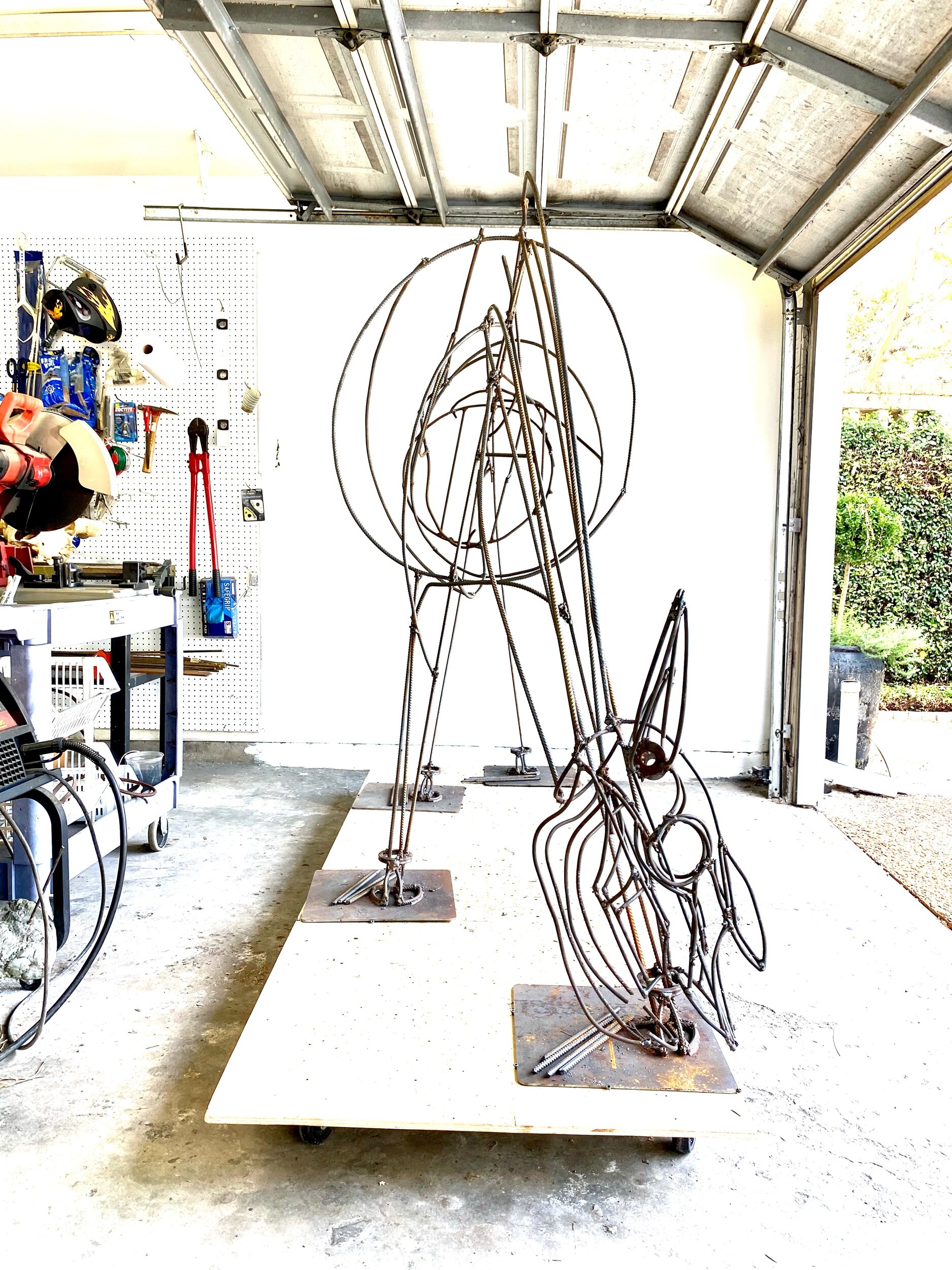
Front legs and right shoulder
Another big day of welding..I added a big 96” circumference chest. Put the entire piece on four dollies and started his hump. Below are a few pics from todays work.

Behind my garage is a telephone pole. I use it to bend my rebar. This is a side view where I am going to bend the piece for the chest.
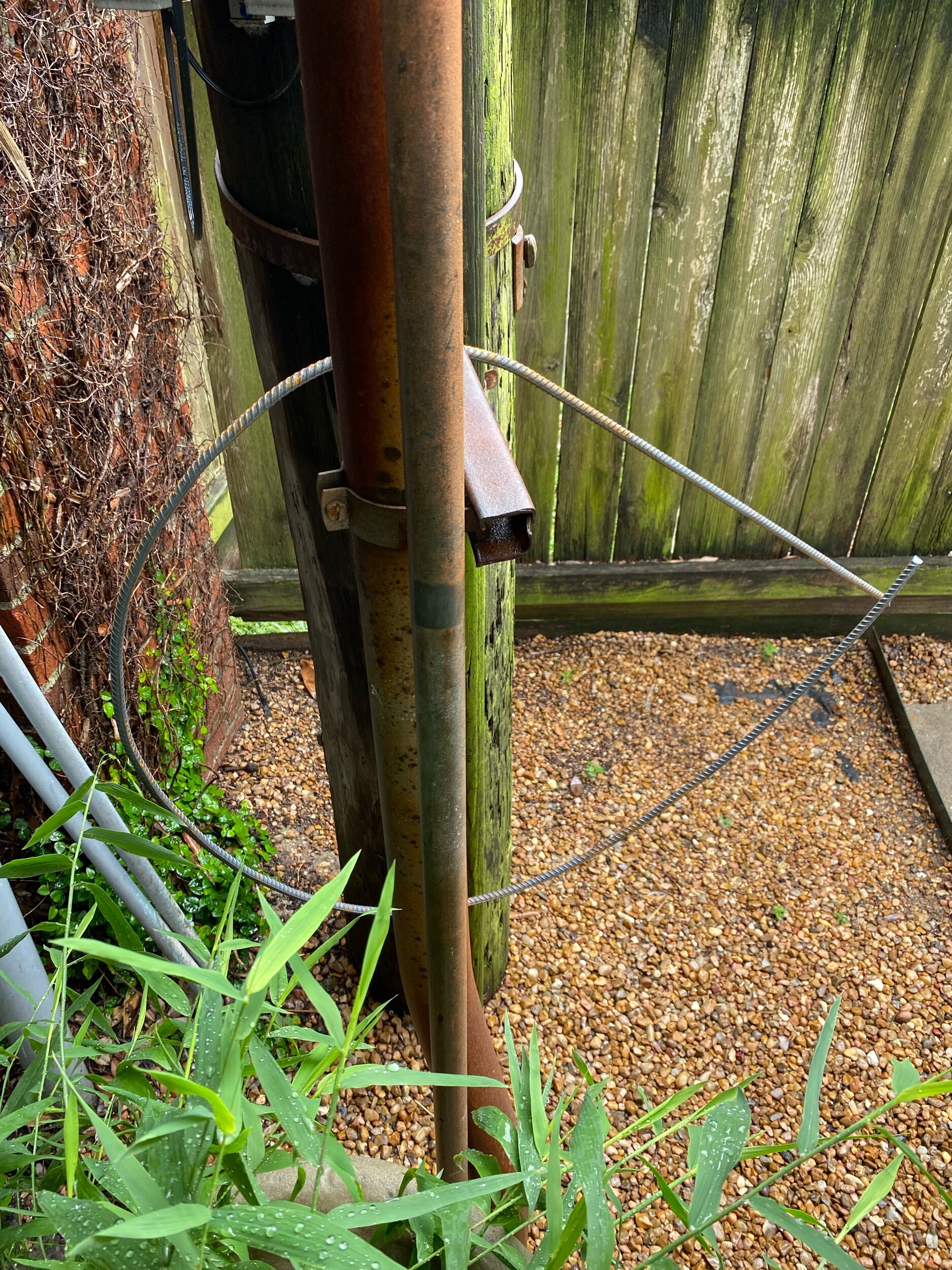
Halfway to becoming a bison chest.

Then I use my weight to even out the shape.

I hang the chest over the back and decide if it is big enough.

Next I weld the ends together .

Recycling some old dollies from past work and deciding on the best plan. Balance and portability is the goal. The brown paper is the footprint of my bisons. Each leg is supported by a dollie.

Thanks to Curtis for getting me the plywood and helping me mount the beast. This is just for while I work on the sculpture and for transportation. It is not part of the work.

Just goofing around

My garage studio assistant is taking a sun break.

Starting to assemble the hump.

And that's a wrap.
July 5th.
Attaching the head—
I welded just one connection from the neck to the head. As I assemble other parts of his body I will continue to evaluate the position of the head. I want him to be his reaching to the side searching for the next blades of grass within the reach of his massive head and tongue. With only one weld I can easily cut it off if I decide it is not in the right place or at the right angle. I do enjoy having a bobblehead bison in my garage for a while.
Building the girt—
I happened to have a circular scrap piece of rebar almost the right size. I created it years ago to be a round seat for a faux bois chair that was started and not finished. I turned it into the basis for the bison’s rear hip girth/stomach.
It is a little small, the small size gives me the flexibility to add to it exactly where I want it to protrude. As I get more elements worked out I will make it larger by adding the back hip bones that protrude. t is a lot easier to add pieces as I build him than to cut out pieces.

1 small tack world neck to head. Just to see where I want it.
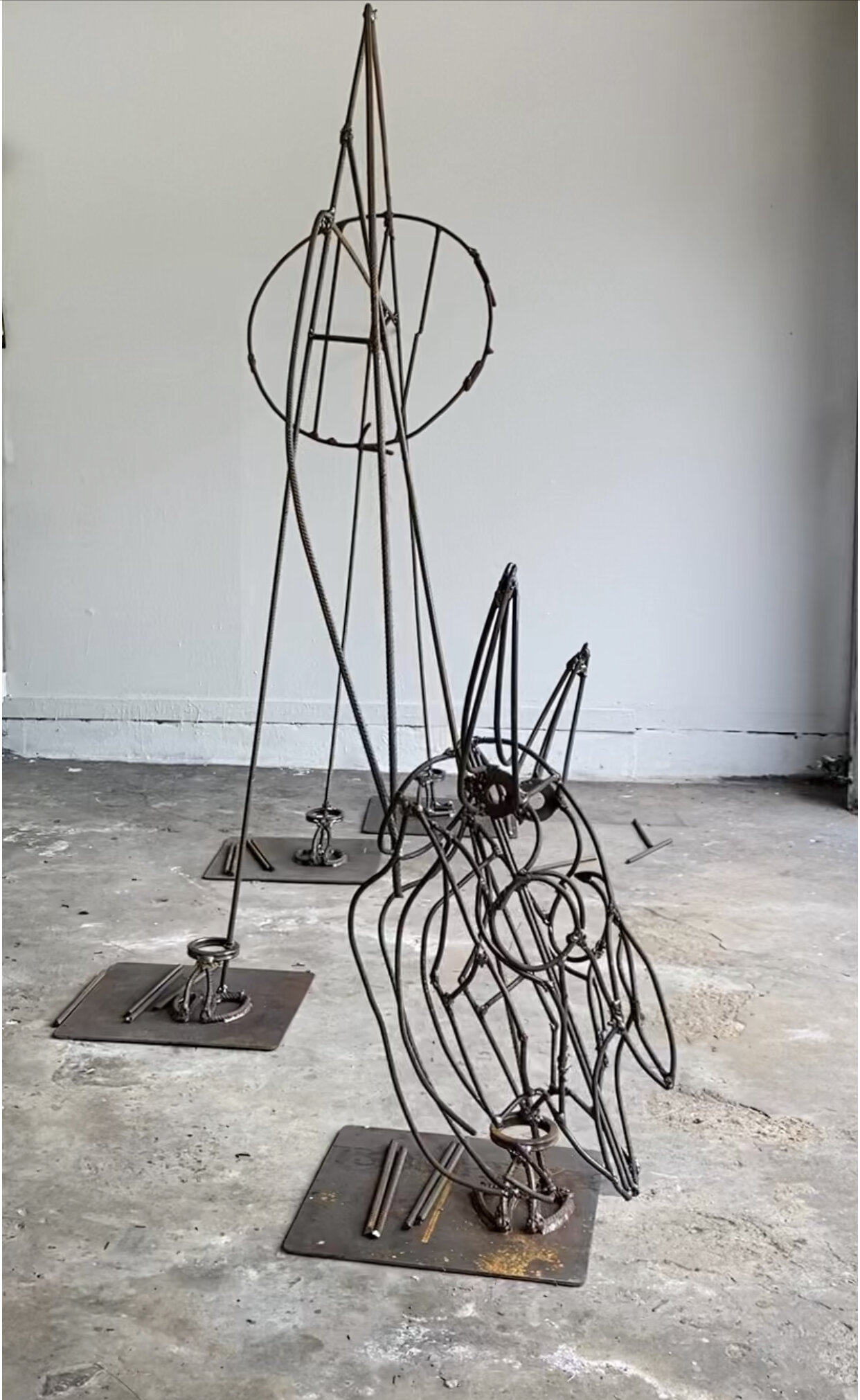

"If you want to make small changes, change how you do things;
if you want to make big changes, change how you see things."
— In Dirt to Soil, Gabe Brown
How do we restore an ecological balance in Houston? We see Houston in the global ecosystem, see our relationship with wildlife and sea life of the western hemisphere.

Houston
See — Houston can balance humanity and urban wildlife.
Site-Specific installation: Symbiosis is a micro-ecosystem in an important ecological space.
Houston is 600 square miles of mostly privately owned land inhabited by 2.3 million organisms, on the Gulf Coast of South-Eastern North America. Its rainwater runoff feeds the ocean and impacts reefs one hundred miles into the seas. Chemicals from Houston are reported killing reefs 100 miles into the Gulf.

Drain
See — The pesticides, herbicides, and fungicides used to keep Houston’s commercial, residential city and county landscapes manicured are leached by rainwaters that drain into the Gulf of Mexico from our streets.
The plants in Symbiosis do not need chemical inputs to thrive. They have evolved to withstand droughts floods and freezing temperatures.
Located near the lower apex of the triangular-shaped North American continent Houston’s land and water provide nesting, hydration, and nutrition for animals that utilize this critical migratory pathway that funnels migratory life between the northern and southern continents of the western hemisphere. More than one in four birds in the U.S. and Canada has disappeared within my lifetime. Birds play crucial roles in maintaining an ecological balance on the coastal prairie, from eating mosquitos to providing food for scavengers and decomposers.

One In Four Birds In the US Has disappeared In My Lifetime.
See — that birds play crucial roles in maintaining an ecological balance on the coastal prairie, from eating mosquitos to providing food for scavengers and decomposers.
Symbiosis is building living soil that supports bugs, beetles and insects that birds need to feed their young.
A male American Robin sits on the fence at Lawndale at the light of day June 18th, 2021 with Gulf fritillary larvae in his mouth. Until Symbiosis was installed birds flew over Lawndale. The garden was sterile of what modern civilization calls landscape pests/what birds feed their young. The sculpture garden did not offer food or habitat for birds.

Larvae of Gulf Frittilary butterfly – Detail of Symbiosis
See — An important nutrient necessary for birds young to thrive.
With native plants in our urban gardens and commercial outdoor spaces, chemical inputs are not necessary. Chemical-free yards will help bring back the 1107 species once common in the Coastal Prairie.
Houston, the site, has experienced extreme flooding and weather conditions. We are located where once was the Coastal Prairie ecosystem that sequestered Carbon like an upside-down rainforest and absorbed water like a sponge. Of that original landscape, only 1% still exists. And yet, we can see an opportunity to capitalize on Houston’s reputation as the city of energy and cultural diversity. We can mitigate global warming and extreme weather conditions by changing how we see our role in a balanced ecosystem.

Lawndale Symbiosis
Lawndale’s sculpture garden is a micro-ecosystem within an important macro-ecosystem that casts a wide net.

Symbionts
The Passiflora incarnata provides nectar for pollinators. Native bees are the original regenerative farmers, they take nectar and regenerate the flower pollinating the Passiflora incarnata.
This is one species of the 4,000 bees native to the US. (Please note this is not a honey bee. Honey bees are not native to the US. They are part of the industrial farming ecological problem.)
I see an opportunity to create the visual for environmental change. I see hope.
“Look closely at nature and you will understand everything better” - Albert Einstein
Look closely at your micro-ecosystem.
To sustain is not enough. Our civilization has depleted the Earth's soil. It is not enough to sustain a depleted planet; we must all do our part and regenerate soil health to sustain life. Regenerating the Earth’s soil is an ongoing DIY project.
ART CAN ONLY ACTIVATE CHANGE WITH YOUR ADDED PERFORMANCE
—If you care about the environment, help get the conversation going and restore an ecological balance in Houston. Post one image of Houston native plants and or wildlife on Instagram #lawndalesymbiosis and tag two friends.
In addition, forward this to two friends.
Ask two friends to do the same, and ask them to ask two more friends, building a pyramid of activism.
For an enhanced experience viewing Houston’s wildlife and landscape I recommend the citizen science apps
“iNaturalist” and “Seek”.
Symbiosis — DIY Steps
Change can happen at lightning speed when innovation is coupled with imitation. Here are the steps I took feel free to imitate them.
I became familiar with the six principles of Holistic Regenerative agriculture through the Savory Institute, Roam Ranch and was recently featured in the film Kiss the Ground. I wanted to make a difference and regenerate depleted land, too. However, a bison ranch is not in my future. It occurred to me that changing how we landscape Houston could make an ecological impact. Lawndale Art Center offered me the opportunity to install an environmental sculpture in the garden. They had just re-landscaped the sculpture garden with a traditional garden, so I did not expect them to accept my proposal. However, Lawndale is committed to artists that explore aesthetic, critical and social issues of our times. Symbiosis is a catalyst to invite the public to change Houstons’s environmental impact. Applying these principles to Houston’s greater urban landscape will significantly impact climate and extreme weather conditions. Houstonians—or anyone—can do this. Climate change is a DIY project.
Below I describe these principles as I applied them to Symbiosis.
See how others across the world have used the same principles I used below.
6 PRINCIPLES of HOLISTIC REGENERATIVE AGRICULTURE AND SYMBIOSIS
Installing this site-specific installation, I incorporated the same principles used to regenerate depleted soils worldwide.
Holistic management — BALANCE —Symbiotic
I keep in mind that the garden is a microsystem that must contribute to and function in the greater ecosystem of the western hemisphere’s continents and waters. In Symbiosis, I balance the needs of the; art institution, urban wildlife, donors, exhibiting artists, the surrounding community, and volunteers.

Holistic management — balancing the needs to run the art center, the neighboring community and urban wildlife/landscape.
Integrating livestock to build soil microbes — GroundWORK
Living soil does not come from synthetic inputs. Instead, it comes from decaying matter that completes the circle of life. Mimicking this process in an urban environment is a crucial step. Without it, there is no life. In the natural world, grazing livestock such as bison, cows, sheep, goats, or chickens provides the decaying matter through their waste, stomping it in the ground and eating and damaging vegetation.
In Symbiosis, I mimic this process by installing a native leaf compost with animal waste components. It is full of beneficial microbes, free of dangerous synthetic chemicals, toxic dyes, and sewage. The heat from composting kills the pathogens. It is safe for children and pets. Because this step is critical, I turned it into a community performance art event. — GroundWORK

Intergrading animal — GroundWORK
Native moldy leaf compost was installed during the GroundWORK event on behalf of RoXoR gin a sponsor of Lawndale’s spring 2021 fundraiser event.
Eliminating tillage — CarbonSINK
While we work to reduce greenhouse gas emissions, it is more critical to sink the Carbon in the atmosphere back into the soil. Carbon is stabile in the roots and microorganisms of plants in the ground. When soil is disturbed, Carbon is exposed to oxygen and transformed into carbon dioxide, which warms the planet. Conversely, organisms can establish communities that feed off the soil's organic matter when the earth is undisturbed. As soil organic matter improves, so does the soil’s internal structure.
A healthy soil biome is vital for suppressing plant diseases and cycling nutrients among plants, eliminating the need for synthetic inputs whose production increases our carbon footprint.
In Symbiosis, I am building a CarbonSINK by not turning the soil over before planting, keeping the soil structure intact as much as possible, and implementing “Chop and Drop” composting when plants go dormant. Symbiosis builds soil biology and increases soil structure, increasing the soil's ability to absorb Carbon and water, reducing runoff, soil erosion, flooding, and preventing pollution from entering nearby bayous.

Eliminating tillage — CarbonSINK
After a freeze in 2022, the red salvia above ground suffered. I carefully chopped all the dead materials and dropped them in the garden. I always leave the roots in the ground and 6” - 10” of stems for solitary native bees to nest in.
Maximizing crop/plant biodiversity, — ReCover
We do not know what we have lost until we recover it.
With this thought, I researched native plants and what roles they have played in the Houston area ecosystem. Identified in the Coastal Prairie are more than 1,000 plus plant species. I have not relied on hybrids/variants of species or plants considered beneficial. Instead, I selected 36 species known as indigenous to the area. Native plants have supported over 4,000 native bees, 1,107 bird species, 750 species of butterflies, 200 skippers, and 11,000 months, and 4,000 wasps.
Symbiosis is to recover and support as many of these species as possible for all four seasons. In addition to supporting wildlife, I sought out plants that helped control ground erosion and water absorption. — Plant it and they will come—

Maximizing Biodiversity — ReCover
Hyla cinerea , there are five true tree frogs in Texas. They climb grass and require a permanent water feature, a trough pond will do. I first saw tree frogs in the garden in September 2021 on a bushy Bluestem. I have since seen them on the Mealy blue sage. I have never seen a 2.5” tree frog in Houston before. I hope we can recover a few for every yard.
Plant material selections: Salvia Lyrata, Calyptocarpus vialis, Phyla nodiflora, Bouteloua gracilis, Carex peredentata, Tradescantia occidentalis, Calyophus brerland, Oenothera speciosa, Rudbeckia hirta, Ratibida columnifera, Monarda citriodora, Echinacea purpurea, Schizachyrium scoparium, Salvia coccinea, Gaillardia pulchella, Symphyotrichum patens, Salvia, Farinacea, Chasmanthium lati, Silphium gracile, Verbena xutha, Salvia azurea, Eryngium yuccifolium, Solidago sempervirens, Capsicum annuum, Callicarpa Americana, Symphoricarpos orbiculatus.
Grasses: Andropogon gerardii Vitman, Schizachyrium scoparium, Chasmanthium latifolium, Carex texensis
VINES: Lonicera sempervirens L, Gelsemium sempervirens, Wisteria frutescens, begonia capreolata, Passiflora incarnata
Keeping the soil covered — Skin = CarbonSINK + GroundWATER = GlobalCOOLING
—Skin, Like human skin the palnet’s skin provides many services necessary for good health.
The Earth’s skin is green. “The Earth is a living organism, composed of millions of species and billions of organisms—bacteria, algae, microscopic insects, earthworms, beetles, ants, mites, fungi and more—representing the greatest concentration of biomass anywhere on the planet. Microbes, which make up only one-half of one percent of the total soil mass, are the yeasts, algae, protozoa, bacteria, nematodes, and fungi that process organic matter into rich, dark, stable humus in the soil." There are more soil microorganisms in a teaspoon of healthy soil than there are people on the Earth! The living organisms in the soil receive their food and shelter from plants' biological processes and physical structure.
In Symbiosis protecting the surface of the work with green skin is an easy decision for me. The quality of the skin is intimately tied to cooling the planet through Carbon and groundwater.

Keeping the soil covered — Skin
—CarbonSINK
I installed the plant material in a manner that mimics how seeds drift in the wind and are carried by animals in their coats or deposited in their waste — resulting in multilayered vertical, horizontal, and diagonal jigsaw puzzles of leaf shapes. These shapes have evolved over thousands of years, woven together to maximize every ray of sunlight. The living material will grow into a three-dimensional solar panel from 6" to 6' tall, sequestering Carbon out of the air and storing it in the living soil. I did not leave the ground bare around each species as is popular in traditional urban landscapes.

CarbonSINK — utilizing a variety of plant shapes to maximize carbon capture.
— GroundWater
Living organisms need oxygen. When rain hits the unprotected ground, the micro spaces that allow air to penetrate the soil collapse and the living organisms die from lack of oxygen. I selected thirty-six species of plants to include various leaf sizes and shapes, stem heights, bloom sizes, and surface textures. As the plants mature, they become a multitiered water slide of twists and turns, slowing rainwater, trickling it to the ground. This allows the Earth to respond like a sponge soaking up the precipitation and channeling it through the root systems and air pockets as freshwater to the aquifer for future generations. Slowing rainwater can mitigate flooding that has become the norm in Houston.
— GlobalCOOLING: Soil soaked in water like a sponge and covered in plants that move, as a gentle breeze blows off the Gulf of Mexico, conditions and cools the air and the earth as it is warmed by the sun. In contrast moving cool rainwater across hot surfaces such as turf grass, artificial turf or concrete landscape, warms the water, picks up chemicals and dumps the urban solar-heated water full of toxic chemicals into the ocean.

GroundWater and GlobalCOOLING — multiple layers of plants slow rainwater, giving the ground time to soak it up, purify and store it in the aquifer.
Maintaining living roots year-round — FoodWEB — GlobalCOOLING
Living roots in the soil are vital for feeding the bacteria and fungi that provide food for the creatures further up the chain. Living roots keep mycorrhizal fungi alive and healthy. These symbionts are vital for nourishing plants and provide convenient fertilizer and water. Maintaining living roots in the ground feeds organisms, providing year-round carbonSINK and GlobalCOOLING.
SMH fall of 2020 was canceled due to Covid 19 last July of 2020. I put a halt on welding my piece and focused on planning “Symbiosis.” “Symbiosis” is installed the Big Show is opened which provided a tremendous amount of traffic. I will still check on it every day, but I will spend most of my day building my piece for SMH 2021. Today I started where I left off. Below are images from last year's work and blog posts.


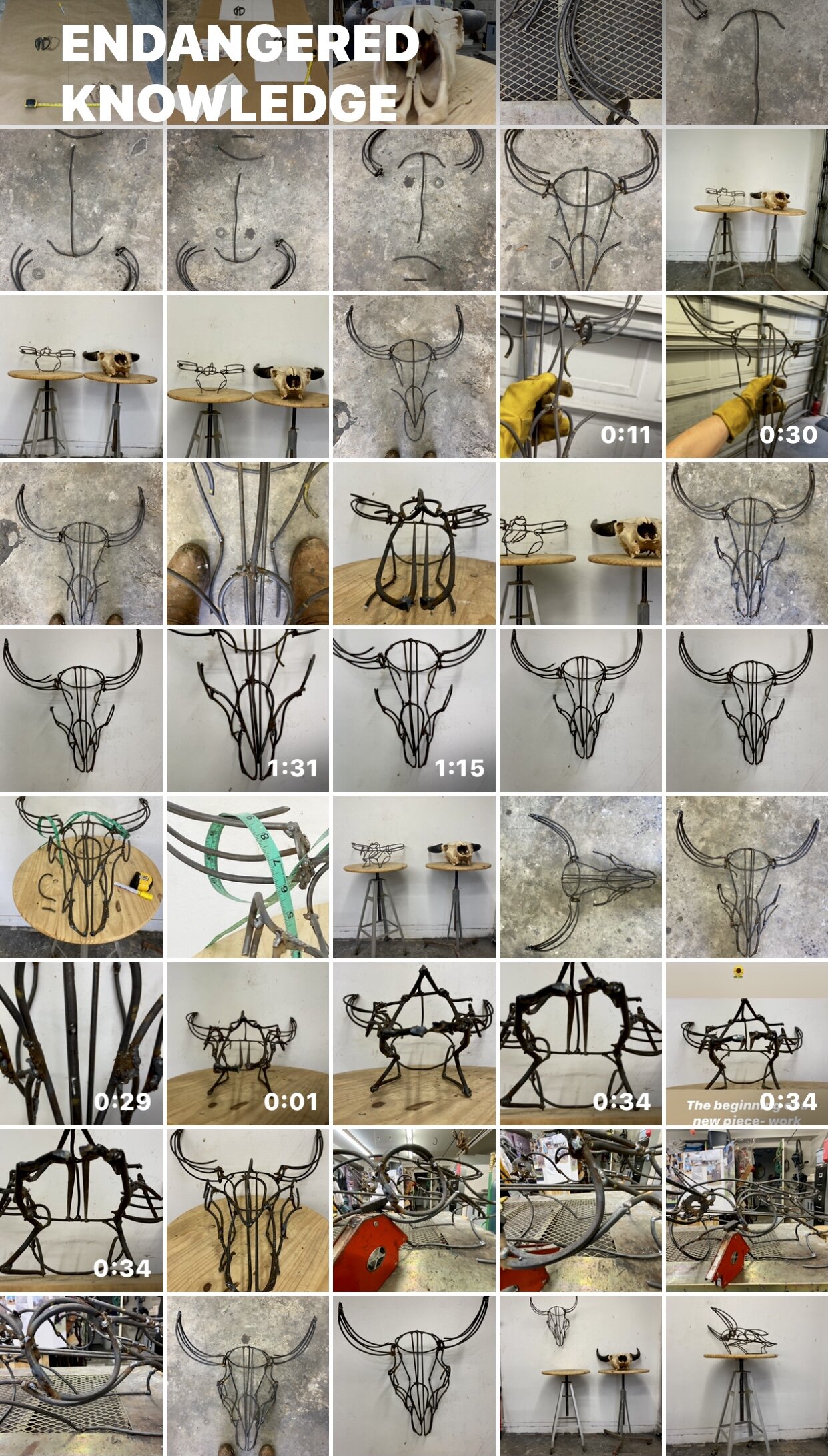

When I stopped in 2020 I had the hooves on steel plate bases and new where I wanted them to bare the weight.

Today I cut the rebar to form the lover part of the legs and grinded the tips. Tomorrow I weld.

Some of my notes from measuring Epics Bob the bison January of 2020.
My bison will be in motion not standing still.

The skull and upper jaw.

And lower jaw

4 pieces of rebar cut for each leg will provide the structure of the lower legs.
I dried some cosmos leaves to us as the coat of a sculpture that is in the works - Endangered knowledge: the Soul of Humus. The piece will be in the #sculpturemonthhouston 2021 exhibit. I started the armature during COVID for the SMH 2020 exhibit, which was postponed. The sculpture looks at the ecological history of the coastal prairie. This texture is perfect #cindeeklementart #endangeredknowledge #coastalprairie #tezasart #houstonart #bioart #environmentalart #cosmos #art #sculpture #bison
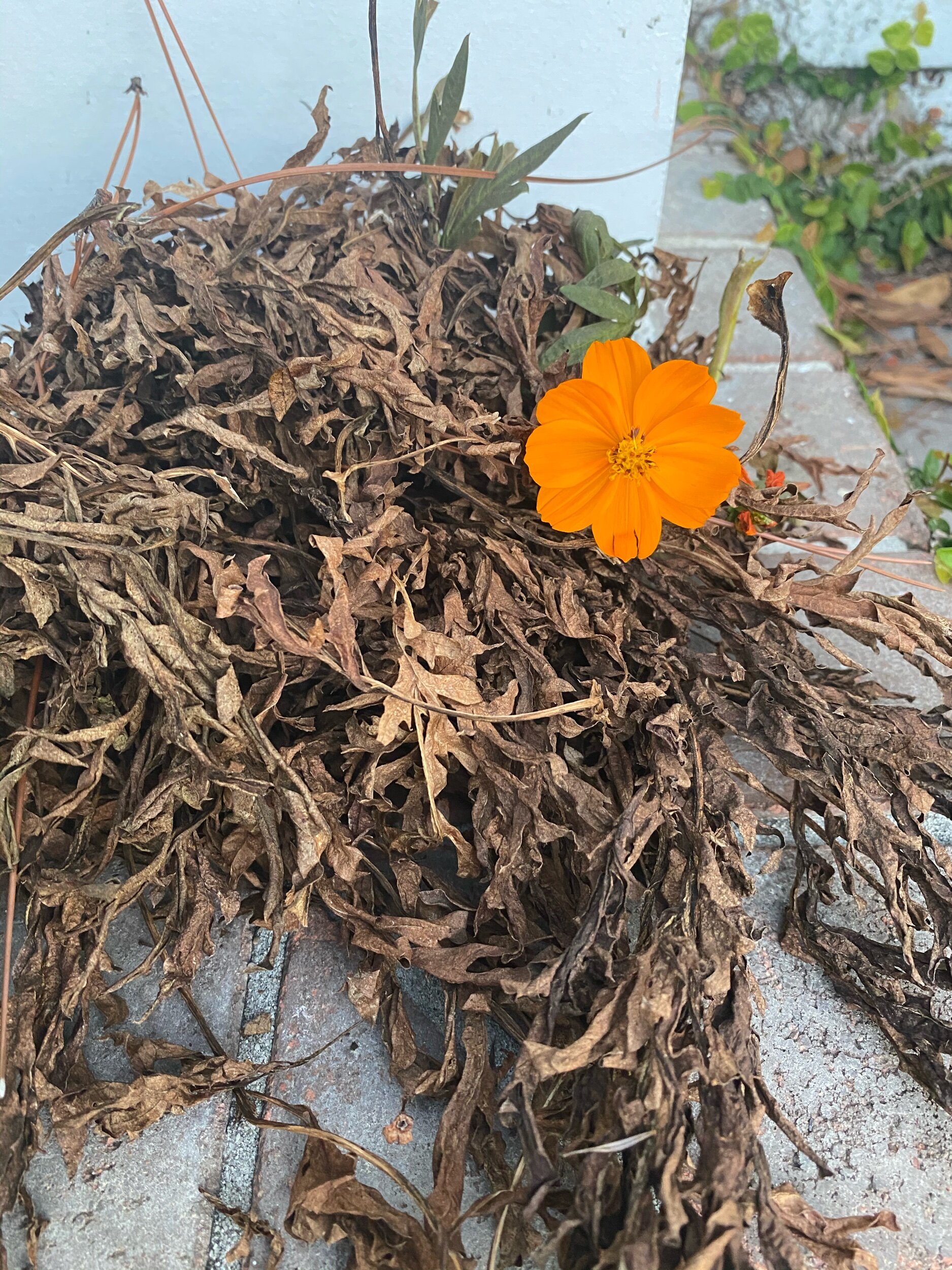

—The last thing you see when you leave the Museum. It is worthy of bookend status to a visit to the Museum; a water feature is a holistic system study. Without a water feature, an urban garden can not be chemical-free. It is a critical component for all walks or flights of urban life. The trailer a hole, whole, and holistic is immersion art.
Read more
ROOT TO WATER
12” X 18” X 12”
found objects: rusted steel irrigation wheel, root
photo by Nash Bake